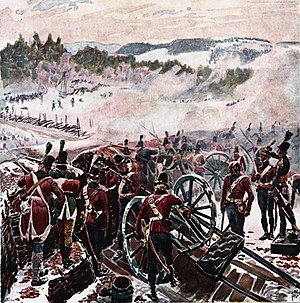Swedish–Norwegian War (1814)
| Swedish–Norwegian War of 1814 | |||||||
|---|---|---|---|---|---|---|---|
| Part of the Napoleonic Wars | |||||||
 Battle of Lier where one of battles of the war took place |
|||||||
|
|||||||
| Belligerents | |||||||
|
|
|
||||||
| Commanders and leaders | |||||||
|
|
|
||||||
| Strength | |||||||
| 30,000 men 8 field batteries 7 brigs 150 gunboats |
45,523 men 117 field batteries 4 ships of the line 5 frigates 24 smaller ships 60 gunboats |
||||||
| Casualties and losses | |||||||
| Unknown | Unknown | ||||||
Swedish victory, Convention of Moss
The Swedish–Norwegian War, also known as the Campaign against Norway (Swedish: Fälttåget mot Norge), War with Sweden 1814 (Norwegian: Krigen med Sverige 1814), or the Norwegian War of Independence; was a war fought between Sweden and Norway in the summer of 1814. The war resulted in Norway entering into union with Sweden, but with its own constitution and parliament.
As early as in 1812, prior to the Napoleonic invasion of Russia, the Swedish Crown Prince Charles John had entered into an agreement with Tsar Alexander I that Russia would support a Swedish attack on Norway in order to force Denmark-Norway to cede its northern part to Sweden. The Swedish attack against Norway was rejected, however, and Swedish forces were instead directed against France in Central Europe. The Swedish troops were deployed against Napoleon's forces as a result of agreements between Charles John and diplomats from the United Kingdom and Prussia, which indicated that Norway would be ceded to Sweden after France and its allies (which included Denmark-Norway) were defeated.
By the Treaty of Kiel in January 1814, King Frederik VI of Denmark-Norway had to cede Norway to the King of Sweden, due to Denmark-Norway's alliance with France, and its defeat during the later phases of the Napoleonic Wars. This treaty was however not accepted by the Norwegians.
...
Wikipedia
